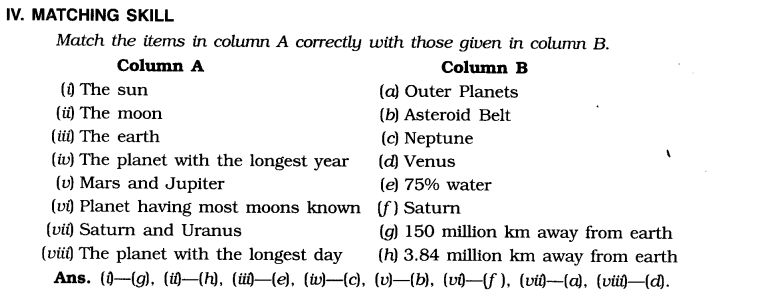1. Answer the following questions briefly.
(a) How does a planet differ from a star?
(b) What is meant by the ‘Solar System’?
(c) Name all the planets according to their distance from the sun.
(d) Why is the Earth called a unique planet?
(e) Why do we see only one side of the moon always?
(f) What is the Universe?
Answer: (a) Differences between a planet and a star:

(b) The term Solar System refers to the “family” of the Sun. The Sun is a star around which eight planets, among other celestial objects, revolve in orbits. This whole system of bodies is called the Solar System. The Sun is the “head” of this system.
(c) The list of planets in the order of their distance from the Sun is as follows:
- Mercury
- Venus
- Earth
- Mars
- Jupiter
- Saturn
- Uranus
- Neptune
(d) The Earth is regarded as a unique planet because of the following reasons:
- It is the only planet known to support life. It has oxygen and water present in proportions that allow life to thrive.
- It also has a temperature range that supports life.
- The proportion of water present is about two-thirds of the surface of the earth when compared to land.
(e) One revolution of the moon around the earth takes about 27 days. Incidentally, the moon’s rotation about its own axis also takes nearly the same time. One day of the moon is equal to 27 Earth days. So only one side of the moon can be seen from the earth.
(f) The Universe is the largest unit in which we live. It is a collection of galaxies. There is only one Universe and everything that exists in this Universe itself.
2. Tick the correct answer.
(a) The planet is known as the “Earth’s Twin” is
(i) Jupiter
(ii) Saturn
(iii) Venus.
(b) Which is the third nearest planet to the sun?
(i) Venus
(ii) Earth
(iii) Mercury.
(c) All the planets move around the sun in a
(i) Circular path
(ii) Rectangular path
(iii) Elongated path
(d) The Pole Star indicates the direction to the
(i) South
(ii) North
(iii) East.
(e) Asteroids are found between the orbits of
(i) Saturn and Jupiter
(ii) Mars and Jupiter
(iii) The Earth and Mars.
Answers: (a)—(iii), (b)—(ii), (c)—(iii), (d)—(ii), (e)—(ii).
3. Fill in the blanks.
- A group of…….. forming various patterns is called a ………….
- A huge system of stars is called ……………
- ……….. is the closest celestial body to our earth.
- ………. is the third nearest planet to the sun.
- Planets do not have their own ………… and ……….
Answers:
- stars, constellation
- galaxy
- The moon
- The earth
- heat, light.
NCERT Solutions for Class 6 Social Science Geography Chapter 1 Multiple Choice Questions
Choose the correct option to complete the statements given below:
(i) Full moon night occurs once every……….
(a) day
(b) 15 days
(c) 20 days
(d) month.
(ii) The Hindi word for the New Moon night is ……….
(a) Amavasya
(b) Krishna Paksha
(c) Poornima
(d) none of these.
(iii) The sun is …………
(a) a star
(b) a celestial body
(c) the head of the solar system
(d) all of these.
(iv) Ursa Major is a/an
(a) star
(b) constellation
(c) galaxy
(d) asteroid.
(v) Which of these was a planet till 2006 but is now a “dwarf planet”?
(a) Neptune
(b) The Sun
(c) Pluto
(d) Solaris.
(vi) The term “Blue Planet” indicates the presence of
(a) land
(b) water
(c) oxygen
(d) all of these.
Answers:
(i)—(d),
(ii)—(a),
(iii)—(d),
(iv)—(b),
(v)—(c),
(vi)—(b).
Fill in the Blanks.
Fill in the blanks with appropriate words to complete each sentence:
- The Amavasya night occurs about ……….. days after the Poomima night.
- Stars are celestial bodies that are ……….. and ………….
- The planets do not possess their own ……….. and …………
- The Small Bear constellation is better known as the ………….
- The Greek word which is the origin of the word “planets” means ………….
- Three planets having rings around them are …………, ………., and …………
- …….. are elongated fixed paths in which a celestial body always remains.
- Venus is similar to the earth in its ………. and ………….
- The shadows on the moon’s surface are due to ……….., ………, and …………
- Meteoroids heat up and bum due to …………
Answers:
- fifteen
- big, hot
- heat, light
- Saptarishi
- wanderers,
- Jupiter, Saturn, Uranus
- Orbits
- size, shape
- mountains, plains, depressions
- friction.
True/False:
State whether these sentences are true (T) or false (F).
- The Sun appears bigger and brighter than the other stars because it is indeed so.
- Saptarishi and Ursa Major are two different constellations.
- The Pole Star is known to have a fixed position in the sky.
- The earth is the only planet that has a natural satellite.
- Pluto was declared a “dwarf planet” in August 2006.
- The earth is the third-largest planet in the solar system.
- The geoid shape is not perfectly spherical.
- The moon takes about the same time in rotating about its axis once as it does to complete a revolution around the earth.
Answers:
- False
- False
- True
- False
- True
- False
- True
- True.



